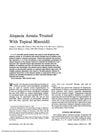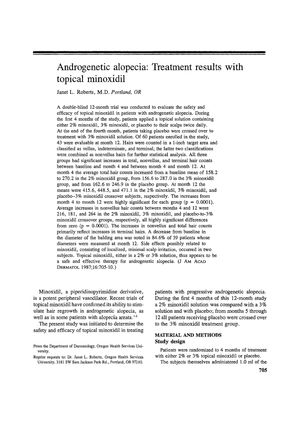TLDR Topical minoxidil is a safe and effective treatment for hair loss caused by androgenetic alopecia.
Topical minoxidil is a safe and effective treatment for androgenetic alopecia, according to a study. Both 2% and 3% solutions of minoxidil were found to promote hair regrowth in patients, with an increase in terminal hairs and a decrease in balding area diameter. The study involved 60 subjects with androgenetic alopecia who were treated with topical minoxidil for 12 months. The treatment was well-tolerated with only minor adverse reactions reported and no significant changes in laboratory tests, except for a slight decrease in blood pressure. Long-term trials are needed to determine if the hair growth is sustained with continued therapy.
 138 citations
,
August 1985 in “Journal of The American Academy of Dermatology”
138 citations
,
August 1985 in “Journal of The American Academy of Dermatology” Minoxidil promotes hair growth in male pattern baldness.
 55 citations
,
February 1985 in “Archives of Dermatology”
55 citations
,
February 1985 in “Archives of Dermatology” Using minoxidil on the scalp can help grow hair for people with hereditary baldness.
 78 citations
,
April 1984 in “Archives of Dermatology”
78 citations
,
April 1984 in “Archives of Dermatology” Minoxidil can help regrow hair in alopecia areata patients.
 3 citations
,
January 2018
3 citations
,
January 2018 A woman had an unusual allergic reaction to a hair loss treatment, which cleared up after stopping the treatment and using a different medication.
 10 citations
,
May 2007 in “PubMed”
10 citations
,
May 2007 in “PubMed” 1% topical minoxidil solution significantly improved hair growth in Japanese women with androgenetic alopecia, with no major side effects.
January 2006 in “The Chinese Journal of Clinical Pharmacology” 2.2% minoxidil gel effectively and safely treats alopecia areata.
16 citations
,
July 1988 in “International Journal of Dermatology” The 2% minoxidil solution is safe and effective for treating male pattern baldness.
 16 citations
,
April 1984 in “Archives of Dermatology”
16 citations
,
April 1984 in “Archives of Dermatology” Topical minoxidil can help hair regrowth in alopecia areata patients, but maintaining the growth after stopping treatment is inconsistent.






